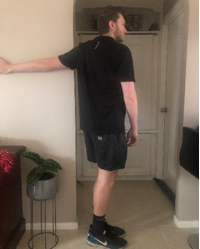Work from home top tips from Tom
In recent times, we have seen a significant transition to ‘work from home’ environments. This has come with some benefits (like working in pyjamas and sleeping in), but it has also brought some aches and pains. Sitting at a desk for hours on end can lead to sudden back aches, neck/shoulder soreness, and some longer lasting postural deficiencies.
Our remedial massage therapist, Tom Moore, has put together a piece explaining common issues and top tips to make sure you’re looking after your body while working from home.
Common injuries that can occur from prolonged sitting can include: straining of the trapezius (pain/soreness just across the upper/middle part of the back and at the back of the neck), or lumber vertebra disk bulging (pain strapping across the lower back). If postural issues such as these are ignored, it can lead to further complications down the track. That’s why it’s extremely important to seek treatment for pain and implement strategies to keep your body healthy.
Remedial Massage focusses on addressing soft tissue conditions by reducing inflammation and increasing blood circulation to dysfunctional sites. This helps to alleviate pain, increase range of motion, and restore the bodies structure to its optimal state.
Some easy – but very effective – things to remember while working at a desk:
- Every 20-30 minutes, stand up and stretch, or walk for 30 seconds to a minute.
- Ensure your seat is providing back arch support and your feet sit flat on the floor with knees at 90 degrees (use a foot stool, if necessary).
- Check that the top of your computer screen sits just below eye level.
- Try to keep your wrists flat while using your mouse/keyboard.
- Try to sit on an exercise ball at your desk for part of the day. This forces you to use core strength and focus on your balance when working. This also enables good posture as your back must be kept arched and feet flat on the floor to keep balanced.
- Stretching throughout the day plays a key part in keeping those aches and pains away, as it will prevent muscle fatigue to your neck, back, and shoulders. Some easy stretches to incorporate into your routine are:
Pec Doorway Stretch:
Stand in a doorway, lift your right arm up and place it against inside of a wall. Gently turn your whole body 90 degrees to the left. Your feet and head should be facing to the left. Shuffle your arm up and down the wall until the stretch is felt at the front of the shoulder. Hold for 10-15 seconds, then switch arms.
Neck Stretch:
Sit on your right hand, then gently lower your left ear to your left shoulder. You should feel a stretch across the right side of your neck. Hold for 10-15 seconds,
then switch sides.


This piece is available in our latest e-Magazine, click here to view in full.





